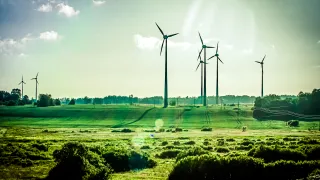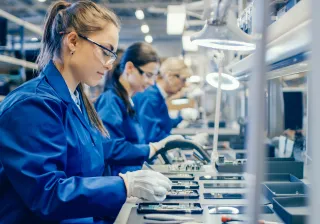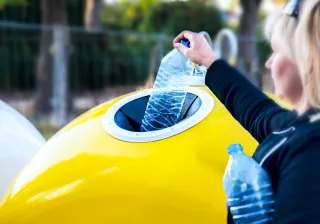Returning materials from consumption to circulation always requires energy. In a comprehensive circular economy emission-free and inexpensive energy must be available in sufficient amounts. If this energy challenge was solved, the atmosphere could also be used as a source of raw materials and food.
Implementing a functioning circular economy requires major changes in energy production, Raija Lantto, Principal Investigator at VTT, reminds us.
"Collecting, sorting, processing and restoring materials back to reusable forms take more energy than using virgin raw materials. Since the use of recycled material must in any case be increased, we are in a situation where we need more and more energy", Lantto points out.
In parallel with promoting a circular economy, humankind must quickly reduce emissions of carbon dioxide and other greenhouse gases just to even slow down climate change.
According to Lantto, solving this double-sided challenge requires an energy transition, i.e. switching to emission-free and preferably renewable energy solutions.
It may not be possible to overcome the challenges with the amount of energy currently available.
"It seems that the need for energy is only going to grow. And because the carbon dioxide content of the atmosphere needs to be limited quickly, we are moving towards the electrification of industry and traffic. The question is how do we produce the electricity or what all can be directly electrified."
Completely clean and renewable sources of energy include actually only solar, wind and hydroelectric power as well as geothermal heat. Nuclear energy is clean from the point of view of emissions, but it is not renewable. Bioenergy, in turn, is not emission-free even though it is renewable.
"The conversion of biomass into energy usually means combustion, and that creates CO2. It is always a better option than burning fossil raw materials, but biomass combustion still increases the CO2 content of the atmosphere in the short term. However, biomass is needed as a raw material for fuels because not all transport and industry can be directly electrified. By using biomass, it is possible to limit the introduction of new fossil carbon into terrestrial circulation."
Since hydroelectric and wind power is available only in limited quantities, expectations are focused primarily on solar energy.
"It must be possible to convert solar energy into electricity very efficiently and in very large quantities in order to solve the Earth's energy dilemma. Nuclear power may also escape its current pariah status."
Help for resource shortage from the atmosphere
The need for energy is also increased by the pressure on the planet's resources, resulting from economic and population growth.
"As production and consumption grow, raw materials and energy are used more and more. Insufficiency of resources is already on the horizon. At some point, we will face an actual shortage of both energy and materials."
"Renewable raw materials will then no longer be enough to cover the shortfall of resources. We must start making food and various products, such as materials and fuels, from carbon dioxide and other components of the atmosphere."
Using molecules present in the atmosphere as a source of food and raw materials sounds revolutionary, and it is.
Technologies to convert chemical components of the atmosphere into a source of raw materials have been known for a long time. Important chemical intermediates, such as hydrocarbons and methanol, can be produced from carbon dioxide. Various chemicals and materials are obtained by processing these intermediates further. In addition, industrial biotechnology is capable of producing customised microbes that can be used to convert carbon dioxide into chemicals and food.
There is only one problem. The chemical methods required are very energy-intensive.
"Using carbon dioxide as a raw material can be done if we have enough inexpensive and emission-free energy available."
Lantto estimates that the utilisation of carbon dioxide will begin where it is easiest.
"Initially, carbon dioxide will be recovered from flue gases of processing and power plants where it will be pre-concentrated and most readily available. The carbon dioxide can then be stored or utilised. Later, carbon dioxide will also be taken from the atmosphere."
Biorefineries are sustainable solutions in many respects, but carbon dioxide emissions are a challenge for them as well.
"Even though some biorefineries produce more energy than they themselves need, carbon dioxide is in any case one of the end products. Quite a large amount of carbon dioxide is dispersed to the four winds even though the other cycles of the factory are closed. The sustainability of refineries would be greatly improved if they recovered and utilised their flue gas. Radical decisions must be made in the next few years."
Food and raw materials from carbon dioxide
VTT has been researching the utilisation of carbon dioxide for several years. Research work as a strategic area began some three years ago, says Research Professor Juha Lehtonen.
"When we started, companies' awareness of the matter was not very extensive. Now, interest has clearly piqued. Companies feel that utilising carbon dioxide is one option for limiting emissions. And where there are big emissions, there are also strong drivers", Lehtonen reminds us.
Lehtonen also thinks that the biggest challenge for the processes is the need for and price of energy.
"Carbon dioxide is very energy-poor as a molecule. It must react with a high-energy molecule, most commonly with hydrogen. Hydrogen can be produced in a sustainable manner electrolytically, i.e. by breaking down water into hydrogen and oxygen by means of electricity. The need for energy is significant in this process."
Lehtonen believes that the energy problem will ease off over time.
"The efficiency of the electrolysis of water, which is central to the process, is constantly improving. Our scenario is that, at some point, a sufficient amount of hydrogen can be available."
Ultimately, the utilisation of carbon dioxide must also be based on business.
"In the long run, it is better if operations are based on genuine business. We need solutions that make the processes profitable", Lehtonen says.
If success is achieved in the utilisation of carbon dioxide, humankind can move into an era of unlimited resources. However, the journey there is long. And first we must tackle resource insufficiency and the ensuing shortage of resources.
"The Earth's sustainability challenge should be solved from the perspective of all kinds of sustainability. However, the basic problem is that we are still prisoners of a linear economy. What is needed now is courage and a new kind of attitude. At every level, there must now be the courage to separate from the established economy. It is a prerequisite for humankind to survive on Earth", Raija Lantto says.
First steps towards resource sufficiency:
- Change in attitude – courage to leave the old and embark on a path to revolutionary change.
- Sharing of commodities, goods and materials.
- Investments in resource and energy efficiency.
- Attention to the development of energy-intensive production processes.
- Keeping critical non-renewable natural resources in circulation.
- Parallel development of carbon dioxide storage and utilisation methods.







